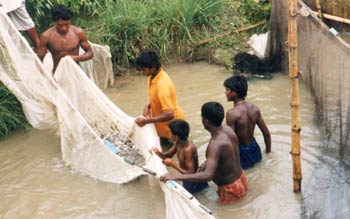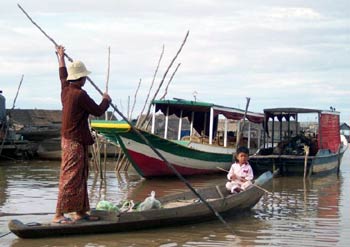 |
Mozaharul Alam describes the next steps needed under the National Adaptation Programmes of Action process in the Asia and Pacific region. |
| The author is a research fellow at the Bangladesh Centre for Advanced Studies, specializing in impacts, adaptation and vulnerability to climate change. He was also National Project Coordinator for the Bangladesh NAPA. | |
In 2001, the seventh session of the Conference of the Parties (COP7) to the United Nations Framework Convention on Climate Change (UNFCCC) decided that all Least Developed Countries (LDCs) under the UNFCCC would prepare a National Adaptation Programme of Action (NAPA). The NAPA would identify immediate and urgent needs for adaptation to climate change. Urgency and immediacy were defined by explaining that further delay in implementation would increase vulnerability or increase adaptation costs at a later stage. NAPAs also recognized the need for action-oriented activities, which should be country-driven, flexible and based on national circumstances.
Responses to the UNFCCC decision
One challenge involved defining immediate and urgent climate change adaptation needs; most countries could only consider what was urgent and immediate in the context of existing climate-related problems, which would be likely to increase in the future thus aggravating impacts. Defining the time needed to implement adaptation activities was also a difficult task. Kiribati, for example, defined a three to five year time span as 'immediate'.
LDC governments have enthusiastically embraced the NAPA process. Out of 15 LDCs in the Asia and Pacific region (ten in Asia and five in the Pacific region), six have already submitted their NAPAs. Amongst these 15 LDCs, five are Small Island Developing States, some of which have low-lying coastal areas or islands, and four are landlocked countries.
All NAPA documents present immediate and urgent national needs in a simple format, easily understood both by policy-level decision-makers and by the general public, as suggested in the annotated NAPA guidelines.
The generic NAPA guidelines were prepared by the LDC Expert Group, and helped the LDCs prepare their NAPAs, primarily using existing information. They include the following steps: synthesis of available information; participatory assessment of vulnerability to current climate variability and extreme events and of areas where risks would increase due to climate change; and identification of key adaptation measures as well as criteria for prioritizing activities. Based on these steps, each NAPA identified a list of priority projects, which were elaborated using the prescribed format and which included short profiles of projects and/or activities needed to address urgent and immediate adaptation needs. Sectoral working groups, a task force-based approach, and an inclusive multi-disciplinary team were all key features of the preparation process.
 |
Fishers, Bangladesh
© John Soussan/SEI |
The key deficiency of NAPAs is that they do not prepare full project design documents, which would allow access to Global Environment Facility-operated funds. Other development organizations also need full project design documents to fund adaptation activities or projects. The methodology described in the annotated guidelines is, therefore, deficient in this respect. Other LDCs still preparing their NAPAs can learn from this and ensure that they prepare full project design documents for at least two or three of their most important projects or activities. This would allow them to access funds for implementation and avoid further delays. The Bangladesh NAPA, for example, proposes that additional resources are required to prepare full project documentation before implementation occurs.
| Preparing the Bangladesh NAPA |
|---|
|
The Bangladesh NAPA preparation process organized four regional stakeholder consultation workshops in the northwest, southwest, northeast and southeast regions. Drought is a recurrent phenomenon in the northwest region and is likely to increase with climate change. The southwest and southeast regions are coastal and suffer from problems relating to salinity and freshwater availability. Saltwater intrusion is expected to increase and freshwater availability is expected to decrease in these areas, particularly in the dry season. The northeast region has low hills and flatter areas prone to flash floods. The regional consultation workshops a) identified existing problems related to climate variability, climate extremes and climate change, and ranked them, b) identified existing coping strategies and measures, c) collected suggestions for improving these existing measures, and d) identified new measures and ideas to address anticipated changes in the intensity and extent of existing problems. Ranking was conducted using the following criteria: security of lives, support to livelihoods, poverty reduction, sustainable development promotion, support to national and community development, gender sensitivity, and synergies with other multilateral environment agreements. |
In general, the NAPAs identify ‘no regret’ projects as urgent and immediate adaptation to climate change needs. Such projects involve capacity building, training, awareness raising, education and developing tools to mainstream adaptation into infrastructure projects. Projects relating to implementation primarily focus on reducing disaster risks and increasing the robustness of infrastructure. The NAPAs recognize the need to mainstream or integrate adaptation into sectoral planning; convincing top-level decision-makers of this is crucial.
Adequacy of existing funding
The UNFCCC and its Kyoto Protocol have created three funds to support adaptation activities: the Special Climate Change Fund, the LDC Fund and the Adaptation Fund.
The LDC Fund is dedicated to the LDCs and contains about US$115 million for implementing adaptation activities. Operational modalities and guidelines for disbursing funds so that adaptation projects developed under the NAPAs can be implemented have been finalized. Currently, several adaptation projects are in the pipeline for funding under the LDC Fund. These address climate change problems in coastal zones, disaster risk management, food security, water resource management, health and ecosystems.
LDCs have the right access to other funds under the UNFCCC and the Kyoto Protocol but it is important to note that competition to access these other funds will be much higher because they can support a wider range of countries and activities. The Special Climate Change Fund, for example, will support transfer of technology and economic diversification along with adaptation.
 |
Cambodia
© John Soussan/SEI |
The Adaptation Fund is intended to fund concrete adaptation projects and programmes in developing countries that are particularly vulnerable to the adverse effects of climate change. Funding is provided by a two per cent levy on proceeds from Clean Development Mechanism projects (excluding those undertaken in LDCs), and other sources. The amount of funding available under the Adaptation Fund will, therefore, depend on the volume of Certified Emission Reduction credits purchased through the Clean Development Mechanism and the market value of those Certified Emission Reduction credits. Institutional arrangements for operating the Adaptation Fund under the Kyoto Protocol are under discussion and are expected to be finalized at the thirteenth session of the Conference of the Parties (COP13) in December 2007.
Estimates from the World Bank Investment Framework and Oxfam suggest that the cost of adaptation for developing countries will be tens of billions of dollars. Current and predicted future availability of funding from the financial mechanisms described above will, therefore, be inadequate under the current modalities. These funds will remain important, but a substantial scale up of available funding is required. This requires a global undertaking - agreed under the UNFCCC - to ensure adequate and predictable funds are made available for adaptation. This could be achieved with mandatory contributions from developed countries, which are primarily responsible for the problem of climate change.
Next steps
Implementing the immediate and urgent climate change adaptation activities identified in the NAPAs is now the most pressing issue for the LDCs. As explicit in the NAPA, any delay in this implementation will increase vulnerability or lead to significant cost increases at a later stage. As explained above, this requires the preparation of project implementation documentation to access funds from the Global Environment Facility and other agencies.
It is also important to note that adaptation is context specific. Activities conducted in some areas may, therefore, not be effective elsewhere. Despite this, sharing lessons learned will help with the implementation of similar adaptation projects and activities that increase the resilience of natural and human systems in different areas. Using a 'learning by doing' approach to implementing adaptation activities will help those LDCs still preparing their NAPA who will be implementing adaptation projects at later stage.
Adaptation measures and development activities are closely linked, and climate change and development communities are gradually accepting this fact. The participation of development organizations in activities undertaken to address climate change impacts is, therefore, indispensable. A number of development partners have already started screening their development portfolios in the context of climate change and identifying possible measures to protect their investments or support adaptation to climate change. Engaging finance and planning ministries in discussions with development partners would help widen the scope of work of development organizations beyond portfolio screening, and support the implementation of activities identified in the NAPA.
Funding for implementing adaptation activities and projects identified under NAPAs, which relate to awareness, training and education, can be justified under Article 6 of the UNFCCC. These projects provide additional opportunities to attract funds from development organizations.
Many Asian and Pacific LDCs have identified projects and activities with a timeframe of three to five years to meet their immediate and urgent adaptation needs. But while progress in formulating and implementing adaptation activities under the NAPA is slowly being made, the challenge of taking urgent and immediate action to meet LDC adaptation needs remains.
More than half the LDCs are still preparing their NAPAs, even though the process started at the international level in 2001. Parties to the UNFCCC should agree that, by the next Subsidiary Bodies Meeting in Bonn in 2008, all Parties should have completed their NAPA. This would make implementing agencies then take the appropriate steps.
Implementation is the only way to meet the primary objective of the NAPAs - meeting urgent and immediate adaptation needs. A decision at the next Conference of the Parties in Bali in December 2007 on a timeframe for implementation should be agreed. Implementation of at least one adaptation project in each LDC should also have begun by this time. This would help raise funds for adaptation and also help build the capacity of implementing agencies.
Further information
Mozaharul Alam, BCAS, House no. 10 (3rd floor), Road no. 16/A, Gulshan-1, Dhaka 1212, Bangladesh. Fax: +880-2-8851417. Email: mozaharul.alam@bcas.net.
On the Web
The Bangladesh and other national NAPAs submitted to date can be downloaded.